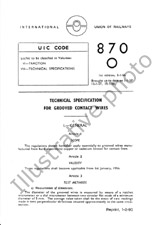We need your consent to use the individual data so that you can see information about your interests, among other things. Click "OK" to give your consent.

UIC 717-2ed.
Recommendations for the design of bridges to satisfy track requirements and reduce noise emissions
STANDARD published on 1.9.2010
The information about the standard:
Designation standards: UIC 717-2ed.
Publication date standards: 1.9.2010
SKU: NS-550366
The number of pages: 20
Approximate weight : 60 g (0.13 lbs)
Country: International technical standard
Category: Technical standards UIC
Annotation of standard text UIC 717-2ed. :
This leaflet contains relevant guidelines for the design of railway bridges in order to meet traffic requirements, given the need to minimise not only track maintenance work but more importantly track maintenance on bridges and their abutments. The importance of reducing noise levels is also highlighted.
The leaflet recommends that bridge design should also allow for longidudinal forces emitted via the rails, and caused by temperature variations or on train braking or again during initial acceleration.
Details are also given of the measures to be adopted as regards:
- the thickness of ballast under sleepers;
- the enclosure of ballasted bridge decks.
The appendices to the leaflet provide examples of ballasted-track laying on concrete or steel bridges, complete with recommended dimensional values.
Name:Empfehlungen für die Konstruktion von Brücken unter Berücksichtigung oberbautechnischer Anforderungen und zur Abminderung der Schallemission|
Dieses Merkblatt enthält nützliche Angaben für Brückenbauvorhaben, insbesondere unter Berücksichtigung Verkehrsanforderungen, um nicht nur den Instandhaltungsaufwand der Brücke selbst, sondern vor Allem die Wartung des auf der Brücke und ihren Enden verlegten Gleises möglichst gering zu halten. Ferner wird auch der Notwendigkeit der Minderung der durch Lärm entstehenden Belästigung Rechnung getragen.
Das Merkblatt empfiehlt die Beachtung der durch die Schienen übertragenen Längskräfte, die durch Temperaturänderungen oder Brems- bzw. Anfahrlasten der Züge entstehen können. Diese Kräfte werden durch das Gleis und dem hinter den Brückenenden liegenden Planum, aber auch durch das Bauwerk selbst, d.h. dessen Unterbauten, aufgenommen.
Ferner wird angegeben, welche Maßnahmen für
die Schotterdicke unter den Schwellen und
die Einfassung des Schotterbettes am Überbau
zu treffen sind.
Die Anlagen enthalten Beispiele für Schottertröge auf Stahl- und Betonbrücken einschl. der empfohlenen Abmessungen


 Cookies
Cookies
